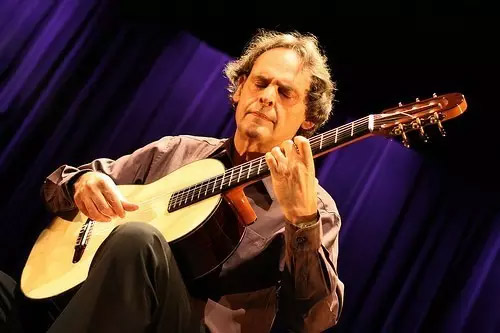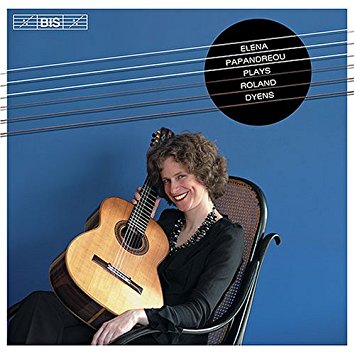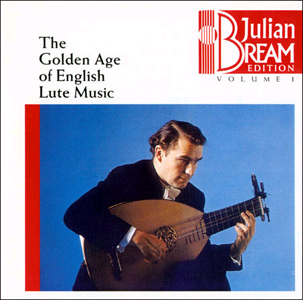罗兰·迪恩斯访谈(2009年古典吉他杂志封面文章)

Catching Up with Roland Dyens: A 2009 Interview
by Ana María Rosado
(From the June 2009 cover story of Classical Guitar)
In the guitar world the old tradition of the composer-performer is alive and well, more so than in any other instrumental category of the classical realm. We may actually be in a new Golden Age of guitarist-composers to rival those of the early 19th century, when the likes of Mauro Giuliani, Fernando Sor, and many others roamed the earth. Among this current crop of creative artists, one that particularly stands out for his prolific output, quality of music, and communicative powers is Roland Dyens. He has made a name for himself with a host of beautiful pieces and continues to add to this legacy with arrangements of popular music from France, Brazil, and beyond, and with virtuosic versions of jazz standards for solo guitar.
The idea for this interview came about in a conversation with Roland at the Newark Liberty Airport, where I visited with him while he was in transit from the US back to Paris, in October 2008. We touched upon his new projects, played guitar in this unusual setting, and he shared the news about a series of new developments in his work. For instance, there was the recent publication of La Guitare: Hôtel de la guitare bleue, a CD/book about the guitar for children from four to six years old. Dyens was chosen by Editions Gallimard Jeunesse to write and interpret the score for this text. Many styles of guitar music meet in the project, from rock to Gypsy. A new Dyens CD on the American GSP label (Guitar Solo Publications) is devoted to the music of the Brazilian genius of chôro, Alfredo Da Rocha Vianna Jr, aka ‘Pixinguinha’ (1898-1973). These arrangements for solo guitar by Roland will also be published by GSP. A ravishing version of several of Fernando Sor’s studies arranged by Dyens for guitar and string quartet has also recently made it into a CD and a published score.
I took this opportunity, at this intense juncture in Roland’s’ life, to ask him a few questions about his motivations and his ideas about the guitar and its future.
CLASSICAL GUITAR: When I first heard your Sor and Giuliani CD, with the arrangements of Sor studies with added string quartet, there was a magical moment for me when the strings come in and transform the familiar into something new. What motivated you to add a string quartet to those Sor studies? In the preface to the published score to the Sor arrangements you state that this was a long-term dream of yours.
ROLAND DYENS: I always wanted to treat the Sor studies my way, but it was Study No.19 that unleashed this mental process several years ago. I dreamed of this study exactly the same way as I later arranged it, with this enchanting tapestry of strings insinuating itself at the reinstatement of the famous arpeggio. This was so evident musically for me that other studies soon followed [nos. 1, 5, 6, 13, 17, and 20 in Segovia’s numeration]. It must be noted that it was the fact of playing with the Arthur-Leblanc String Quartet at Domaine Forget in 2005 that definitely pushed me into this adventure of a rereading of these perennials, or “evergreens” of the guitar repertoire.
CG: What other pieces from the standard repertoire would you consider ready for this treatment, if any?
DYENS: Obviously there are many other guitar pieces that, in my opinion, would deserve the same fate as “my” Sor Studies. Imagine the splendid results that Villa-Lobos’s Preludes or some of Francisco Tárrega’s gems could yield with added string quartet, for instance. Let’s stop while we are ahead; I could get dangerous ideas—but maybe one day…
CG: Your approach to rhythm is that of an ensemble player, in that you play as if a drummer were behind you. Actually, in one of your arrangements of jazz standards, in Night and Day, you have added a vibraphone to the arrangement. Are these arrangements based on your idealized sound of a jazz ensemble, or is there a particular version on which you based your arrangements?
DYENS: No, I did not refer to any pre-existing arrangement to write them. These solo guitar versions are meant to suggest or evoke other instruments, from the jazz quartet to the big-band; the only arrangement for duo was written for the sumptuous combination of guitar and vibes, which I had explored for a long time before. By the way, it’s the same approach in my recent work on Pixinguinha’s music—I do not wish to refer to any version whatsoever of these pieces when I make my own. This is my way of preserving a total freshness. Of course, you can find certain traits that hail from historic versions of the pieces, but those are integral parts of the standards, a kind of musical signature, or DNA. When I start an arrangement project, whichever it may be, I look first and foremost to harvest the melody in its purest and most naked form. Then I begin to “dress” it; a good arranger must be like an inspired grand chef or a high-fashion designer.
I have a short anecdote to finish with this subject. The editor of one of the most important Jazz magazines in France, Jazz Hot, wrote a review of my CD upon its launch. Although in general terms it was very complimentary he could not help concluding the article with these words: “It is nevertheless a pity that Roland Dyens did not avail himself of the services of double-bass player or a drummer to make this recording.” He definitely did not get it.
CG: Pixinguinha’s music is enjoying a renaissance in Brazil. Is that how you became interested in arranging his chôro music for solo guitar? You seem to have a strong instinct for Brazilian music, as evidenced by your early 3 Saudades. Is that a personal preference?
DYENS: I used to claim that I was Brazilian in one of my previous lives. I deeply feel as if I were a Brazilian artist and citizen. Popular Brazilian music is definitely one of the two most sophisticated popular musics in the world, together with Indian music. So it is not because of the current Pixinguinha revival that I decided to work on this music. The project was very probably sleeping in my heart for years and years. And it woke up on a day in September 2007, all of a sudden, in the middle of a “pixtune” played by a Brazilian student at a workshop in Lisbon, Portugal. After he played, I stood up and hugged him like crazy. He probably thought it was because of his interpretation, but it was not only because of that. Then I thanked him for being the small click that was needed in order to start my “pixwork.”. This student, Virgilio Gomes, is actually a great Brazilian bass guitar jazz player. Later, he was the one who sent me the huge PixRealbook, which includes over a hundred tunes from which I—with much difficulty, because all of them are pure jewels—selected the eleven “winners” that I came to arrange.
CG: It is very difficult to reach the mainstream of music through the guitar, either as a performer or as a composer? Is writing music just for the guitar or guitar-based pieces a completely satisfying compositional venue for you?
DYENS: Well, you’re tackling an important issue here. Writing for the guitar is the most challenging issue I actually know. And that is why it is completely suited to my temperament—that of a crazy risk-taker. Is it the guitar which has made me a risk-lover, and hence a little crazy, or was I crazy already? That is the question.
Certainly it is particularly tricky to write or arrange well for the guitar. It requires a perfect knowledge both of the history and the geography of the instrument. But isn’t that precisely what forces us, come what may, to go deep into thought, to search for clarity, for evidence, and to search for the essence? Iisn’t that what forces us to find viable solutions in difficult contexts, solutions that come to the rescue of this or that musical idea that is worth saving? Excessive freedom, in my opinion, kills creativity. And that is the reason why I love the guitar and its limits. Paradoxical? Maybe a bit.
CG: Have you written pieces without guitar in them?
DYENS: Not yet. I’ve always thought that it is better to forge ahead in a field that I master and for a music sphere where my name is established, rather than to venture into a universe where I do not have a real media presence. I think to myself, “What oboe player is going to want to play Roland Dyens when, after decades of work, I have a beautiful audience of guitarists and guitar aficionados?” My belief may not be the general consensus; for example, the saxophone and the accordion professors at the Paris Conservatory are encouraging me to write for their instruments. My mind is not closed to the possibilities—absolutely not, and I rather like the idea.
CG: Your guitar music is very intricate and challenging to play. Lately you have produced easier music, in the case of the 20 Letters and, I imagine, the children’s book. Is that harder for you to do—to write easy music?
DYENS: Yes, extremely hard. When I finished writing the 20 Letters eight years ago, I honestly thought I had never written anything easier and that they were, in fact, very easy. Truth be told, they require at least four years of guitar study to be able to approach the easier ones. That fact has only increased my desire to tackle that real challenge again. To write very simple and very “sexy”—that’s the thing!
CG: How many of your published compositions may have started as improvisations in your concerts, other than the Valse des Loges?
DYENS: It is not quite that, my dear friend. The truth is, first of all, that my compositions are never born from improvisations on stage, but hail instead from an intense and thorough effort at my desk. They may sometimes be born in a theater or a concert hall, but within the green rooms of these—I find them very inspiring—which is a very different proposition. What happened with that piece is that I had finished composing it a few minutes before going on stage, and the risk- and the danger-lover in me could not resist the temptation of giving its premiere that same night. That’s the real story behind my Valse des Loges.
CG: You are in a noble tradition with Debussy and Ravel, Chabrier and Rimsky-Korsakov in writing “nationalistic” music from an outside perspective: 3 Saudades, Valse des Anges [Angel’s Waltz], Tango en Skaï, to mention just some, with a very organic approach to Brazilian and Latin music. Do you study the rhythms and then recreate them in your music, or do you let your musical instinct go with it?
DYENS: I never really studied any of these rhythms as ethnomusicologists do. On the other hand, I’m a real living and listening witness of the musics of the world. Look at Valse des Anges, for instance. That piece, dedicated to my friend Russ De Angelo, was pretty quickly composed in a green room in Dana Point, California. It’s rather a map of Latin America, than a waltz, I think. Rather than being a nationalistic musician, I feel like a sponge actually. And I feel more like a nationalistic musician for others than for my personal use, let’s say. Have I written any French-flavored pieces? Well, maybe. What about my 26 arrangements on French songs? Then it’s unconsciously.
CG: In rendering homage to many composers through your pieces, you usually mention their names in the titles: Eloge de Léo Brouwer, L.B. Story, Hommage Frank Zappa, and Hommage à Villa-Lobos. In the 2005 Valse des Anges there is no mention of Antonio Lauro or of his Natalia waltz, yet it is paraphrased throughout. Is that an insider’s joke or a “wink-wink,” as you rather charmingly put it? It is a Venezuelan vals criollo capped by a malambo quote: you nailed the styles and their connection!
DYENS: You’re right, Valse des Anges is a pan-South America waltz. I’m aware there are a lot of gestures of various typical Latin folk music in it—not to mention the Brazilian harmonic flavor all through it. As you say, the very beginning of this piece starts like Natalia by Lauro, which might imply a similar kind of “wink-wink,” as I already did in an old composition of mine also inspired by Lauro: Tristemusette, dedicated to the memory of Marcel Dadi because he loved Lauro’s music. But this kind of musical reference belongs now more to the public domain than to its father, in a way.
CG: Djembé, a new solo guitar piece, has pitches that can only be played in an alternative version for guitar, flute and string quartet. Isn’t that a jarring juxtaposition—an African-percussion based piece for quintessentially European instruments?
DYENS: Well, what you say about the quintessence of Djembé is interesting and relevant, but a bit far from my original goal, I must say. So let me explain how things happened. I had a concert scheduled in Paris in December 2007 and, for some reason, I thought this concert could be a perfect opportunity to play a piece together with my son Emmanuel for the first time ever. At 21, he is an outstanding drummer, composer, and singer. So I composed Djembé and dedicated it to him. We eventually performed it twice in a theater called l’Archipel. On the same night, I was expected to also premiere my Sor arrangements for string quartet and guitar and play some new piece of mine for flute and guitar. So it came quickly to my mind that I had to do something to get all this great company on stage and play something together for the grand finale of this concert. Thus the second version of Djembé was born. Funny how things can happen sometimes.
CG: Do you have a crystal ball? What is the future of the classical guitar?
DYENS: OK, now listen to the guru: I humbly think that if young players would only play Segovian repertoire on and on, things won’t move at all. Don’t misunderstand me: We all objectively owe something to Andrés Segovia and his repertoire—the word “objectively” being the operative one. But since no one can prevent the classical guitar “new wave” of composers and players to spread through—or invade, or “spoil”—the entire repertoire, then my crystal ball predicts our future will be definitely interesting in term of modern classical guitar. We have a nice saying in French: des racines et des ailes—“roots and wings.” It means there is no future if there is no love and consideration for the past. And it’s the same with music.

